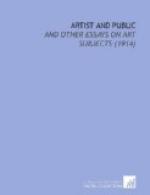It is not probable that any critic who greatly valued his reputation, or who had any serious reputation to value, would take quite this tone; but, leaving out of consideration the impressionistic and ultra-modern criticism which ignores Raphael altogether, it is instructive to note the way in which a critic so steeped in Italian art as Mr. Berenson approaches the fallen prince. The artist who used to be considered the greatest of draughtsmen he will hardly admit to be a draughtsman at all, ranking him far below Pollaiuolo and positively speaking of him as “a poor creature, most docile and patient.” As a colorist and a manipulator of paint, he places him with Sebastiano del Piombo—that is, among the mediocrities. Almost the only serious merit, from his point of view, which he will allow him is a mastery in the rendering of space, shared in nearly equal measure by Perugino, as, to some extent, by nearly all the painters of the Umbrian school. For, while he admits that Raphael was the greatest master of composition that Europe has produced, he evidently thinks of composition, as do so many other moderns, as a matter of relatively little importance.
It is not Raphael’s popularity that is in question; that is, perhaps, as great as ever it was. His works, in one form or another of reproduction, from the finest carbon print to the cheapest lithograph, are still to be found, in the humblest homes as in the most splendid, in nearly every quarter of the globe. That popularity was always based on what Berenson calls the “illustrative” qualities of Raphael’s work, on the beauty of his women, the majesty of his men; on his ability to tell a story as we like it told and to picture a world that we wish might be real. One may not be prepared to consider these illustrative qualities so negligible as do many modern critics, or to echo Mr. Berenson’s phrase about “that which in art ... is so unimportant as what ... we call beauty.” One might point out that the greatest artists, from Phidias to Rembrandt, have occupied themselves with illustration, and that to formulate the ideals of a race and an epoch is no mean task. But, for the moment, we may neglect all that, our present inquiry being why an artist, once counted the greatest of all, is no longer considered very significant by those who measure by purely artistic standards rather than by that of illustrative success and consequent popularity.




